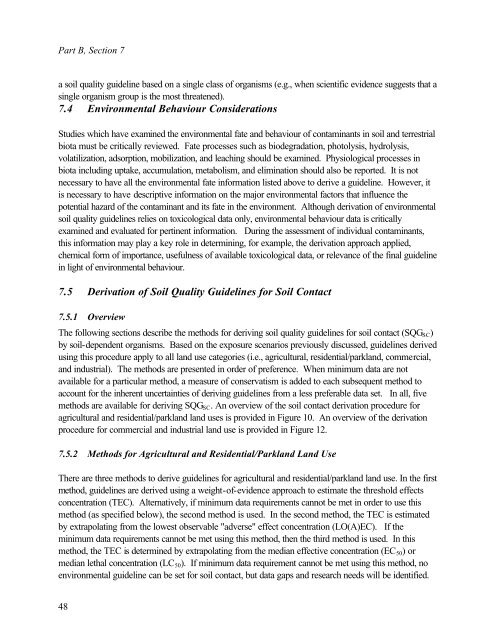Protocol for the Derivation of Environmental and Human ... - CCME
Protocol for the Derivation of Environmental and Human ... - CCME
Protocol for the Derivation of Environmental and Human ... - CCME
Create successful ePaper yourself
Turn your PDF publications into a flip-book with our unique Google optimized e-Paper software.
Part B, Section 7<br />
a soil quality guideline based on a single class <strong>of</strong> organisms (e.g., when scientific evidence suggests that a<br />
single organism group is <strong>the</strong> most threatened).<br />
7.4 <strong>Environmental</strong> Behaviour Considerations<br />
Studies which have examined <strong>the</strong> environmental fate <strong>and</strong> behaviour <strong>of</strong> contaminants in soil <strong>and</strong> terrestrial<br />
biota must be critically reviewed. Fate processes such as biodegradation, photolysis, hydrolysis,<br />
volatilization, adsorption, mobilization, <strong>and</strong> leaching should be examined. Physiological processes in<br />
biota including uptake, accumulation, metabolism, <strong>and</strong> elimination should also be reported. It is not<br />
necessary to have all <strong>the</strong> environmental fate in<strong>for</strong>mation listed above to derive a guideline. However, it<br />
is necessary to have descriptive in<strong>for</strong>mation on <strong>the</strong> major environmental factors that influence <strong>the</strong><br />
potential hazard <strong>of</strong> <strong>the</strong> contaminant <strong>and</strong> its fate in <strong>the</strong> environment. Although derivation <strong>of</strong> environmental<br />
soil quality guidelines relies on toxicological data only, environmental behaviour data is critically<br />
examined <strong>and</strong> evaluated <strong>for</strong> pertinent in<strong>for</strong>mation. During <strong>the</strong> assessment <strong>of</strong> individual contaminants,<br />
this in<strong>for</strong>mation may play a key role in determining, <strong>for</strong> example, <strong>the</strong> derivation approach applied,<br />
chemical <strong>for</strong>m <strong>of</strong> importance, usefulness <strong>of</strong> available toxicological data, or relevance <strong>of</strong> <strong>the</strong> final guideline<br />
in light <strong>of</strong> environmental behaviour.<br />
7.5 <strong>Derivation</strong> <strong>of</strong> Soil Quality Guidelines <strong>for</strong> Soil Contact<br />
7.5.1 Overview<br />
The following sections describe <strong>the</strong> methods <strong>for</strong> deriving soil quality guidelines <strong>for</strong> soil contact (SQG SC )<br />
by soil-dependent organisms. Based on <strong>the</strong> exposure scenarios previously discussed, guidelines derived<br />
using this procedure apply to all l<strong>and</strong> use categories (i.e., agricultural, residential/parkl<strong>and</strong>, commercial,<br />
<strong>and</strong> industrial). The methods are presented in order <strong>of</strong> preference. When minimum data are not<br />
available <strong>for</strong> a particular method, a measure <strong>of</strong> conservatism is added to each subsequent method to<br />
account <strong>for</strong> <strong>the</strong> inherent uncertainties <strong>of</strong> deriving guidelines from a less preferable data set. In all, five<br />
methods are available <strong>for</strong> deriving SQG SC . An overview <strong>of</strong> <strong>the</strong> soil contact derivation procedure <strong>for</strong><br />
agricultural <strong>and</strong> residential/parkl<strong>and</strong> l<strong>and</strong> uses is provided in Figure 10. An overview <strong>of</strong> <strong>the</strong> derivation<br />
procedure <strong>for</strong> commercial <strong>and</strong> industrial l<strong>and</strong> use is provided in Figure 12.<br />
7.5.2 Methods <strong>for</strong> Agricultural <strong>and</strong> Residential/Parkl<strong>and</strong> L<strong>and</strong> Use<br />
There are three methods to derive guidelines <strong>for</strong> agricultural <strong>and</strong> residential/parkl<strong>and</strong> l<strong>and</strong> use. In <strong>the</strong> first<br />
method, guidelines are derived using a weight-<strong>of</strong>-evidence approach to estimate <strong>the</strong> threshold effects<br />
concentration (TEC). Alternatively, if minimum data requirements cannot be met in order to use this<br />
method (as specified below), <strong>the</strong> second method is used. In <strong>the</strong> second method, <strong>the</strong> TEC is estimated<br />
by extrapolating from <strong>the</strong> lowest observable "adverse" effect concentration (LO(A)EC). If <strong>the</strong><br />
minimum data requirements cannot be met using this method, <strong>the</strong>n <strong>the</strong> third method is used. In this<br />
method, <strong>the</strong> TEC is determined by extrapolating from <strong>the</strong> median effective concentration (EC 50 ) or<br />
median lethal concentration (LC 50 ). If minimum data requirement cannot be met using this method, no<br />
environmental guideline can be set <strong>for</strong> soil contact, but data gaps <strong>and</strong> research needs will be identified.<br />
48
















